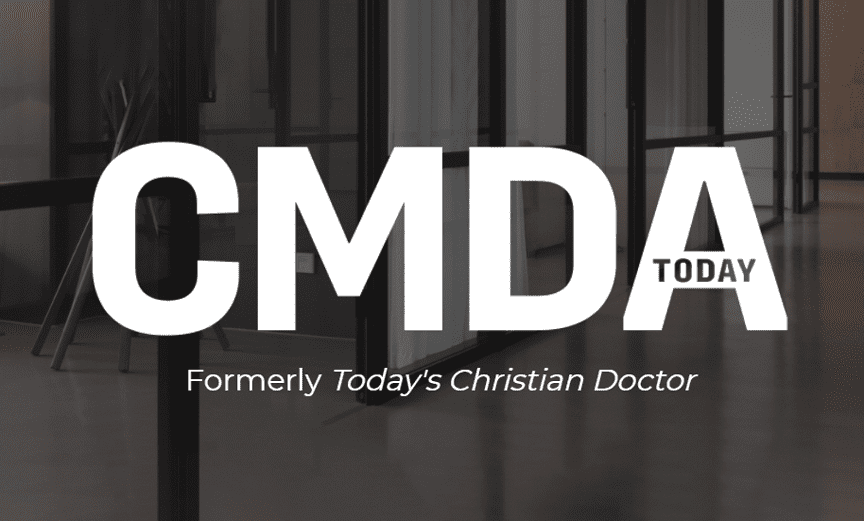
CMDA Statement: Advance Directives
Whereas modern medicine has made available technologies that can prolong life, medical science alone cannot answer questions of whether life-sustaining technologies should be used in particular circumstances or whether such technologies are consistent with patients’ goals of care, values, and beliefs about health, life, and death.
by Christian Medical & Dental Associations®
Whereas modern medicine has made available technologies that can prolong life, medical science alone cannot answer questions of whether life-sustaining technologies should be used in particular circumstances or whether such technologies are consistent with patients’ goals of care, values, and beliefs about health, life, and death. Therefore, patients should have the opportunity, while they have capacity, to indicate their desires about the use or nonuse of specific treatment modalities and to designate a surrogate (sometimes called healthcare proxy or agent) to make decisions on their behalf if they become incapacitated.
Definitions:
- Advance Care Planning: the ongoing process whereby the patient, in conversation with family and healthcare professionals, receives information about the types of life-sustaining treatments that are available, shares personal values, and makes decisions about medical care the patient would want to receive if no longer able to speak for himself or herself. Advance care planning may lead to completing a written advance directive.
- Advance Directive (or Advance Medical Directive): a patient’s medical directive, which may be a discussion, a written statement, or an audio or video recording, specifying what medical actions should be taken for the patient if, because of incapacity, the patient is no longer able to make decisions for himself or herself. An advance directive is a legal document. An advance directive has inherent limitations; as a static document, it may not anticipate all developing clinical scenarios as medical circumstances change, and it may not reflect the nuances of a patient’s preferences or choices in every potential context. Types of advance directives include:
- Durable Power of Attorney for Health Care: a legal document that authorizes someone the patient trusts to be a surrogate decision-maker, that is, to make medical decisions on behalf of the patient in the event that the patient becomes incapacitated.
- Living will: a written statement detailing a person’s desires regarding his or her medical treatment in circumstances in which he or she is no longer able to express informed consent, especially an advance directive.
- AND (Allow Natural Death): a positive medical term defining the use of life-extending measures that emphasize comfort rather than life extension.
- DNR (Do Not Resuscitate): a physician’s order, placed with the patient’s or surrogate’s consent, directing the withholding of cardiopulmonary resuscitation (CPR) and advanced cardiac life support (ACLS) in the event of cardiac or circulatory arrest. DNR means that electrical therapy, chest compressions, external cardiac pacing, or any medication intended to reverse cardiac arrest will not be provided to an unresponsive pulseless patient.
- DNI (Do Not Intubate): a physician’s order, placed with the patient’s or surrogate’s consent, specifying the withholding of endotracheal intubation and ventilatory support during cardiac arrest or non-arrest circumstances.
- POLST (Physician Orders for Life-Sustaining Treatment): actionable physician orders, signed also by the patient or surrogate, that support other forms of advance directives and are transferrable (implementable) across healthcare settings and the home. These vary in terminology and application from state to state, including signature by APRN or PA rather than physicians only, some examples being:
- POST (Physician Orders for Scope of Treatment)
- MOST (Medical Orders for Scope of Treatment)
- MOLST (Medical Orders for Life-Sustaining Treatment)
- DNR/COLST (Do Not Resuscitate Order / Clinician Orders for Life-Sustaining Treatment)
- TPOPP (Transportable Physician Orders for Patient Preferences)
- VSED (Voluntarily Stopping Eating and Drinking): the decision of a patient who has decisional capacity to stop eating and drinking by mouth for the purpose of hastening death in the setting of unrelieved suffering. It may include a directive not to be hospitalized.
In formulating and applying advance directives, the following areas should be considered:
- Biblical
- God who gave us life is ultimately sovereign over the timing of our death.
- There is an appointed time for death (Gen 6:3; Eccl 3:1-2; Psalms 89:48, 116:15, 139:16).
- God is able to intervene in human affairs using natural or supernatural means. He frequently chooses to accomplish his purposes through human hands or medical technology, but he is not limited by those means.
- God may allow suffering at the end of life to accomplish his inscrutable purposes. An advance directive should not be interpreted as seizing that control from God (Job; 1 Peter 4:19; Romans 5:3-5; 2 Corinthians 12:9).
- The whole counsel of Scripture, as expressed preeminently in the healing ministry of Jesus Christ, endorses the merciful relief of suffering in anticipation of the final defeat of evil, when Christ will wipe away every tear and make all things new (Revelation 21:4-5).
- Death for the Christian is not failure but victory through Christ (Romans 6:8, 14:7-9; 1 Corinthians 15:54-56; 2 Corinthians 5:8; Philippians 1:21-23).
- We as beings created in the image of God have moral responsibility. Scripture provides guidance on how Christians should view the end of their lives, which is important as a basis for making good decisions regarding healthcare choices.
- We are stewards of our bodies, our health and our resources, and therefore we are responsible to God for our lifestyle and healthcare choices (1 Cor 3:16,17, 6:19-20).
- Scripture provides a moral basis for making healthcare decisions on behalf of others (Mark 12:28-34; Luke 10:25-37; Phil 2:4; Gal 6:2; 1 Tim 5:8).
- Our inevitable decline in health is never fully within our control (John 21:18; 2 Cor 4:16).
- There is in Scripture a tension between viewing death as an enemy and as a defeated enemy through Christ. Death is our enemy (1 Cor 15:26,57; Phil 1:21-26). However, death is not the ultimate evil. As Christians we are freed from the fear of death (Heb 2:15).
- Biological
Aging, illness, and death are inevitable.
- Social
- The expanding powers of medical technology to extend life have contributed to cultural anxiety over the reality of natural death while also presenting patients, their families, and healthcare professionals with difficult decisions.
- There are many reasons why advance care planning conversations do not occur:
- discomfort in discussing death,
- lack of appreciation of importance,
- lack of understanding of terminology and options,
- a sometimes overwhelming number of potential decisions to be made,
- breakdown in communication because of unresolved family conflict,
- the belief that God will direct the time of death, so we dare not intervene,
- assumption that the medical system will do what is right, and
- patients’ inability to reflect on or express their values to their surrogates.
- Decreased interpersonal connectedness, geographical separation of families, divorce, and greater social isolation have contributed to a shift to emphasizing individual autonomy in lieu of authorizing a trusted surrogate decision-maker.
- Medical
- CPR is unique among medical procedures in that it is the default, not requiring a patient’s permission. Choosing to forego CPR by electing a DNR is one of the most important decisions a patient and his or her physician can make. If this discussion has not taken place, initiating CPR on a patient who would not desire it can cause considerable end-of-life suffering.
- Healthcare professionals and patients’ surrogates are frequently faced with difficult end-of-life treatment decisions on behalf of patients who do not have an advance directive or who have not communicated their goals of care.
- When patients opt not to communicate their preferences, once incapacitated, others will decide for them. The ultimate decision-maker may be someone the patient would not have chosen: it may be someone unfamiliar with the patient, or it may not even be a family member; it may be someone whose values the patient would not embrace.
- The complexities of end-of-life medical choices necessitate naming a surrogate who can speak on behalf of the incapacitated patient as medical circumstances change.
- Using a patient’s advance directive to limit interventions at the end of life can relieve moral distress of the surrogate decision-maker.
- POLST orders are actionable across medical settings; as such, they have the benefit of decreasing patients’ moral distress by removing the need to ask patients repeatedly about their end-of-life decisions as care settings change.
- A limitation of POLST orders is that they are not designed to accommodate context-specific medical decision-making. Additionally, in some states a POLST could be void if it contradicts a pre-existing advance directive. A broad directive to decline resuscitation does not take into account changing clinical circumstances in which, for example, a brief course of mechanical ventilation or cardioversion might enable to the patient to return to his or her previous state of health.
- Ethical
Implementing Advance Directives
- Advance directives are an important aspect of ethical care. It is imperative for patients and their physicians to discuss goals of care in an unhurried, uninterrupted, and thorough manner. Out of respect for the patient’s dignity, it is essential that the patient understand the potential benefits and burdens of aggressive end-of-life treatment before decisions are made.
- The benefits and burdens of CPR will vary with the clinical context and, therefore, should be reviewed with the patient or surrogate as the disease context changes. For example, CPR performed after a primary cardiac event in an ICU will have far greater benefit and less burden than when attempted outside of the hospital or when the cardiac arrest is caused by a noncardiac process.
- The patient who has an advance directive has the obligation to communicate it to the potential surrogate and to medical caregivers.
- The surrogate who is chosen must be willing and able to speak on behalf of the patient and to make difficult decisions when necessary.
- The designated surrogate is obligated, within legal constraints that may vary by jurisdiction, to follow:
- a “substituted judgment” standard: what he or she thinks the patient would choose if able, or, if that is not possible,
- a “best interest” standard: what a reasonable person in a similar situation would choose.
Treatment and Nontreatment Decisions
- Whereas suffering can produce strength of character (Romans 5:4), no patient is obligated to forego analgesic interventions. Medical professionals should offer any palliation possible to relieve their patients’ pain and suffering, to the exclusion of intentionally hastening death.
- When natural death approaches, the option of withholding or withdrawing treatment should always be considered.
- Patients have the right to refuse any medical treatment. Honoring a patient’s advance directive for nontreatment does not equate to euthanasia.
- A suicide attempt is not an indication for medical nonintervention. A request by an individual (or surrogate) for discontinuation of life-sustaining treatment shortly after surviving a suicide attempt should not be automatically honored. In these situations time may be needed to allow the patient to transition beyond the coerced state of depression and despair that led to suicidal ideation in order to engage in informed consent about treatment options. Once the medical evaluation is complete, the patient is no longer actively suicidal, and the patient or surrogate has had an opportunity to receive adequate information to make an informed and uncoerced decision, it may be appropriate to carry out a refusal, expressed at the time or through an advance directive, of ongoing treatment of the underlying disease or the medical consequences of the attempted suicide. To discontinue therapy prior to such an evaluation risks making the physician or healthcare team complicit with suicide rather than allowing natural death.
- A decision to withdraw a medical treatment should not be interpreted as withdrawal of care. Even when nothing more can be done medically to treat a patient’s illness, there is still much that can be done for the patient. While treatments may be discontinued, care should always remain.
- A DNR status does not mean “do not treat.”
- Medical technology is inherently expensive, but treatment decisions should not be based primarily on economic considerations.
- A patient with an advance directive may be a potential organ donor, but treatment decisions should not be based primarily on preserving transplantable organ viability.
- When medical indications are unclear or the patient’s prior wishes are uncertain, a medically appropriate time-limited intervention may be an ethical alternative to committing prematurely to an ongoing treatment or nontreatment decision.
- Whereas the intent of an advance directive is to honor the patient’s autonomy, autonomy is not an absolute principle. Healthcare professionals also have responsibilities not to harm but rather to do good, as well as to listen, to educate, and to provide compassionate care. Making a nontreatment decision in accordance with an advance directive that did not take into account a current unforeseen clinical context, or making a default treatment decision for a patient who did not understand an advance directive document well enough to fill it out, is not necessarily to honor the patient’s autonomy.
- Not all treatment requests, at the time of care or in an advance directive, are ethically appropriate. In situations where the patient’s request violates the healthcare professional’s moral or religious values, then the healthcare professional should discuss this with the patient and allow transfer of care if the conflict cannot be resolved. (See CMDA position statements on: Assisted Suicide, Euthanasia, Right of Conscience in Health Care)
VSED (Voluntarily Stopping Eating and Drinking)
- Patients have the right to refuse oral eating or drinking and to change their mind.
- Whether patients should be allowed to request physician assistance in VSED through an advance directive has been a subject of controversy. The decision whether to offer palliation to symptoms of dehydration or starvation needs to be made in the immediate context consistent with the physician’s right of conscience.
- An ethical dilemma may arise when a cognitively impaired patient who requests food or drink has previously signed a VSED advance directive requesting that healthcare professionals withhold spoon feeding and orally administered hydration. In these situations, it is ethically appropriate to honor the advance directive in regard to medical interventions such as intravenous fluid or tube feedings. However, it is ethically impermissible to withhold ordinary food and water to the patient who requests them, as these represent normal human care and interaction and are not considered medical treatment. Healthcare professionals have the right to offer spoon-fed nutrition and orally administered fluids to all patients who desire them and to whom they can be provided safely. A previously stated desire for VSED should not overrule a conscious patient’s expressed desire for oral feedings. (See CMDA position statements on Artificially Administered Nutrition and Hydration; Double Effect; Euthanasia and Assisted Suicide)
POLST (Physician Orders for Life-Sustaining Treatment)
- Patients may elect to sign a POLST document as an advance directive in the event of serious illness with limited life expectancy. POLST forms should be filled out only after a meaningful discussion with the patient and family or surrogate. The discussion should be documented in the medical record. These documents are most appropriate for those patients who are terminally ill, are likely to have multiple or frequent interactions with the healthcare system, and have significant chronic or life-limiting illness.
- Standing orders dictating future treatment decisions are ethically appropriate only if the patient’s preferences are stable over time and across foreseeable clinical contexts. Some forms require review and renewal at least on an annual basis.
- Whereas POLST is appropriate in regard to CPR, decisions about the use or nonuse of fluids and nutrition and about time-limited treatment trials are better addressed through the patient’s advance directive or discussion of goals of care with the patient’s surrogate than through the automatically invoked POLST form.
- It is important that physicians whose practice involves end-of-life considerations and consultations be aware of the extent to which these orders are legally binding.
- Many iterations of POLST orders are exceptionally detailed and complex, and it is incumbent upon healthcare professionals to ensure that the patients and their surrogates have an adequate understanding of the implications of the orders, to the end that the vulnerable are not placed at risk.
- Efforts to provide comfort care and pain management are always appropriate, and most variations of POLST address this imperative.
Conclusion
- The role of the physician is to affirm human life, relieve suffering, and give compassionate, competent care as long as the patient lives. The physician as well as the patient will be held accountable by God, the giver and taker of life.
- Advance directives are biblically, medically, and ethically appropriate. Advance directives should be recommended to all adult patients regardless of health and reviewed and updated periodically.
- An essential part of an advance directive is the patient’s discussion with designated family or other close associates and the healthcare team about the patient’s values and wishes.
- Healthcare professionals should assist patients with advance care planning in accordance with patients’ beliefs, values, and preferences, particularly when they are clearly and consistently expressed.
- Conversations about death, dying, and end-of-life medical care should be a routine part of church ministry, focusing not just on eternal destiny, but also on how Christians’ end-of-life decisions should be consistent with their belief that death has been defeated through Jesus Christ.
- Advance directives should never be used as a means to physician-assisted suicide or euthanasia.
- Healthcare professionals should honor their patients’ medically appropriate advance directives and recognize this as an opportunity to respect their dignity as made in the image of God.
Approved by the CMDA House of Delegates
Passed Unanimously
May 2, 2019
Ridgecrest
References
Ache K, Harrold J, Harris P, et al. Are advance directives associated with better hospice care? J Am Geriatr Soc 2014; 62(6): 1091-1096.
Bischoff K, O’Riordan DL, Marks AK, et al. Care planning for inpatients referred for palliative care consultation. JAMA Intern Med. 2018; 178(1): 48-54.
Hickman SE, Keevern E, Hammes BJ. Use of the physician orders for life-sustaining treatment program in the clinical setting: a systematic review of the literature. J Am Ger Soc 2015; 63: 341-350.
Ivanović N, Büche D, Fringer. Voluntary stopping of eating and drinking at the end of life – a ‘systematic search and review’ giving insight into an option of hastening death in capacitated adults at the end of life. BMC Palliat Care 2014; 13: 1. doi: 10.1186/1472-684X-13-1
Kaldjian LC.. Erekson ZD Haberle Terre Haute, et al. Code status discussions and goals of care among hospitalized adults. J Med Ethics 2009; 35: 338-342.
Kapp MB. Overcoming legal impediments to physician orders for life-sustaining treatment. AMA J Ethics 2016; 18: 861-868.
Kendra AM, Rubin EB, Halpern SD. The problems with physician orders for life-sustaining treatment. JAMA 2016; 315: 259-260.
Olick R. Defining features of advance directives in law and clinical practice. Chest 2012; 141(1): 232-238.
Quill TE, Byock IR. Responding to intractable terminal suffering: the role of terminal sedation and voluntary refusal of food and fluids. ACP-ASIM End-of-Life Care Consensus Panel. American College of Physicians-American Society of Internal Medicine. Ann Intern Med 2000; 132(5): 408-414.
Redmann AJ, Brasel KJ, Alexander CG, et al. Use of advance directives for high-risk operations. Ann Surg 2012; 255(3): 418-423.
Silveira MJ, Kim SYH, Langa KM. Advance directives and outcomes of surrogate decision making before death. N Engl J Med. 2010; 362(13): 1211-1218.
Sleasman MJ, Cox M. Special Report: Examining POLST (Physician Orders for Life-Sustaining Treatment). Dignitas 2015; 22 (4). The Center for Bioethics & Human Dignity. Accessed at: https://cbhd.org/Dignitas/Winter-2015-polst-supplement
Tolle SW, Moss AH, Hickman SE. Assessing evidence for physician orders for life-sustaining treatment programs. JAMA 2016; 315: 2471-2472.
Tolle SW, Teno JM. Lessons from Oregon in embracing complexity in end-of-life care. New Engl J Med 2017; 376(11): 1078-1082.










